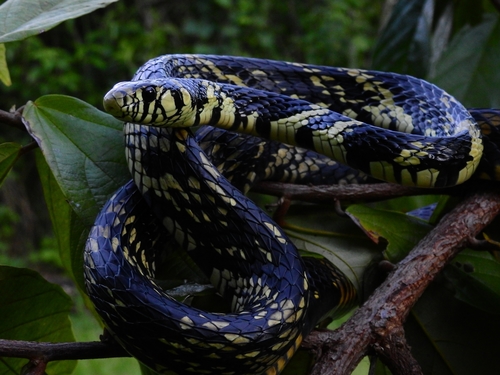
Tiger Rat Snake
The vibrant Spilotes pullatus, or Tiger Rat Snake, dazzles with black and yellow bands. A masterful climber, it roams Central and South American rainforests, preying on birds and mammals. Its presence is vital for controlling rodent populations, showcasing nature's balance of beauty and function.
10-18 years
Lifespan
Length: 1.2192 - 2.1336 m
Size
Yellow, Black, Multi-colored
Color
Medium
Aggression
Least Concern
Conservation Status
Stable
Population Trend
Characteristics
Spilotes pullatus, commonly known as the Caninana or Tiger Rat Snake, is a large, non-venomous snake native to Central and South America. It is known for its striking black and yellow banded pattern, which aids in camouflage. This species thrives in tropical rainforests and is an adept climber, often seen hunting for birds and small mammals.
Distribution Range of the Tiger Rat Snake
Spilotes pullatus, commonly known as the caninana or black-and-yellow ratsnake, is native to Central and South America. Its geographical distribution includes countries such as Mexico, Belize, Honduras, Nicaragua, Costa Rica, Panama, Colombia, Venezuela, Guyana, Suriname, French Guiana, Brazil, Ecuador, Peru, Bolivia, and Paraguay.
Tiger Rat Snake's Habitat
Environmental Conditions
The species typically inhabits tropical rainforests, tropical and subtropical moist broadleaf forests, and sometimes dry forests. It is adaptable to various altitudes but is predominantly found at lower elevations. The environmental conditions in these habitats include warm temperatures, high humidity, and dense vegetation.
Ecological Niche
Spilotes pullatus is an arboreal snake, meaning it is well adapted to living in trees. It plays a vital role in the ecosystem as both a predator and prey. It primarily feeds on birds, small mammals, and occasionally lizards and amphibians, thus helping control these populations. Its presence in the canopy and forest floor layers allows it to contribute to the ecological balance within its native habitat.
Copyright @ Nature Style Limited. All Rights Reserved.
 English
English